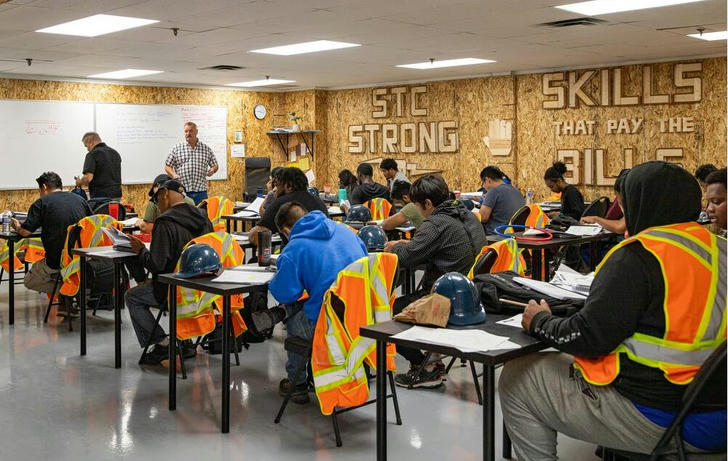Get Paid to Learn HVAC: Government-Funded, 12-Week, and Paid Training Options in the U.S.
If you’re thinking about getting into the HVAC trade, good news: demand is strong, pay is solid, and there are multiple ways to train while getting paid or having your tuition supported by government/workforce programs. Below I lay out the realistic pathways (what’s government-funded, what a 12-week fast-track looks like, real paid-training examples), plus how to pick a program and what certs employers actually want.

Why HVAC is worth attention right now
Heating, air conditioning and refrigeration mechanics/installers are in demand — the Bureau of Labor Statistics lists a median annual wage near $60,000 (May 2025) and projects faster-than-average job growth over the next decade. That means employers are hiring and often willing to invest in training.
Government-funded routes — how they actually work
1.Registered Apprenticeships (paid on-the-job training). These are federal/state-registered programs that combine paid field work with classroom hours; apprentices earn a paycheck from day one and get progressively higher wages as skills increase. Registered Apprenticeship is industry-driven and validated by the U.S. Department of Labor. If you want to earn while you learn, this is the most established route.
2.Workforce programs (WIOA) and local American Job Centers. The Workforce Innovation and Opportunity Act (WIOA) funds training for eligible jobseekers (dislocated workers, low-income adults, etc.). Many community colleges and training providers list WIOA eligibility — check your state’s workforce site or CareerOneStop to find approved HVAC programs that can be paid for through WIOA.
3.Community college partnerships and state grants. Many community colleges run accelerated HVAC bootcamps or pre-apprenticeship classes that are WIOA-approved or supported by state workforce grants — a practical bridge into apprenticeships or entry jobs.
The “12-week” fast-track — what to expect
A growing number of schools and bootcamps advertise 12-week accelerated HVAC programs that focus on core technical skills and certifications (EPA 608, basic electrical, refrigeration fundamentals, OSHA 10). These programs are designed to make you job-ready faster and often include job placement or short paid internships with partner employers. Examples include college bootcamps and private accelerated programs (several community colleges and providers run 12-week tracks). They’re not a substitute for multi-year apprenticeships for advanced specialties, but they can be a fast entry point.
Paid-training programs run by employers — real examples
Some national HVAC contractors run “get paid to train” schemes where you earn a wage while you train on the job. For example, large employers (like CoolSys and other national firms) advertise paid entry programs where trainees can earn around $15–$20/hour during training and gain tools, mentoring and a path to a full technician role. These programs are worth exploring if you prefer learning directly on real jobs and being paid immediately.
Certifications employers expect (short list)
🔹EPA Section 608 — required by law for anyone who handles refrigerants; most employers expect at least the universal or relevant type.
🔹OSHA 10 (or OSHA 30) — common for jobsite safety awareness.
🔹NATE or equivalent technician certifications — useful for credibility and some employers.
🔹Manufacturer training (e.g., controls, rooftop units) is a plus.
Getting EPA 608 and OSHA 10 early makes you far more hireable out of a short program.
How to find government-backed or paid HVAC training (step-by-step)
1.Start at Apprenticeship.gov — search “HVAC” and your ZIP to find local registered apprenticeship openings. These list sponsoring employers and application steps.
2.Contact your local American Job Center / CareerOneStop — ask about WIOA-funded HVAC training providers and eligibility rules.
3.Check community college continuing-education pages — many run 12-week bootcamps or pre-apprenticeship programs that lead to on-the-job placements. Look for program pages that note WIOA approval.
4.Search employer programs — large HVAC contractors list paid trainee programs on their careers pages (search “paid HVAC training” + company name).
What to expect on earnings and career path
Apprentices typically start at a trainee wage and get scheduled pay increases as they complete years/levels. The BLS median (~$59k) is reachable after you gain experience and certifications; specialized techs or those in commercial/industrial service can earn more.
How to choose a good program — a quick checklist
🔸Is it a Registered Apprenticeship or WIOA-approved? (that usually means paid or funded support)
🔸Does it include EPA 608 + safety training? (non-negotiable for refrigeration work)
🔸Are employers listed as partners, and is there a placement rate? Programs with employer partners usually get you into a job faster.
🔸What’s the real time commitment and cost to you? Even when government-funded, you may still need tools or a small materials fee — ask up front.
🔸Ask former students — reviews, LinkedIn alumni, or local union halls can tell you what graduates actually earn.
Final blunt advice
If you want to get paid while you learn: prioritize registered apprenticeships and employer-run paid trainee programs. If you need a faster entry, a high-quality 12-week bootcamp plus EPA 608 and OSHA 10 can get you into entry roles or an apprenticeship interview. Use Apprenticeship.gov, CareerOneStop and your local community college as your three starting points — then call the employers listed and ask about hiring timelines.
Registered Apprenticeship Program
